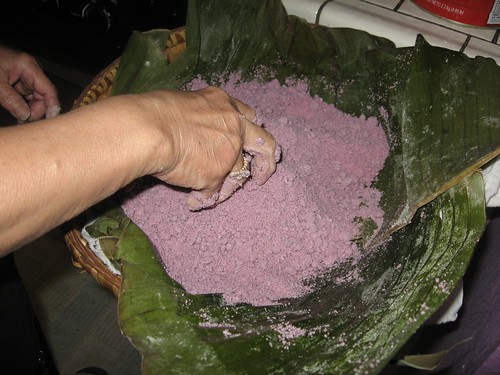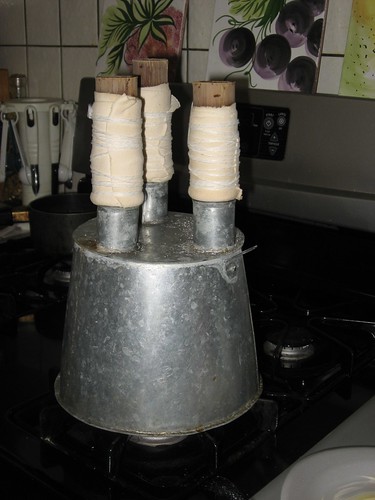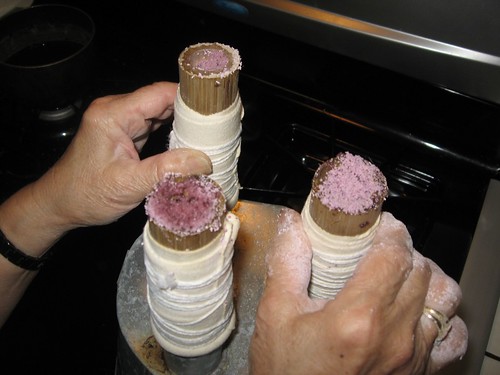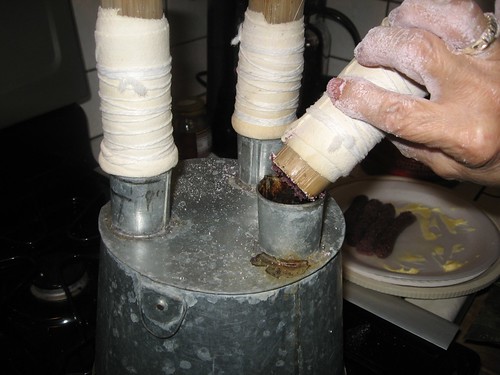Puto Bumbong is a Filipino delicacy that’s traditionally served during the Christmas season in the Philippines. It literally translates to steamed glutinous rice (puto) cooked in bamboo (bumbong), and it’s a staple at my best friend’s house, where we gather for Noche Buena at midnight on Christmas Eve. The purple color comes from the mixture of sweet rice and black rice (pirurutong), but I’ve seen recipes that call for purple food coloring, which is obviously cheating! Puto bumbong is served with butter, sugar and freshly grated coconut on top. I asked my friend’s mom if she would show me how to make puto bumbong, and she was happy to oblige.

Cooking puto bumbong is fairly quick but preparing the rice is a three-day process. On the first day, you take a mixture of equal parts of sweet rice and pirurutong and soak it overnight. On the second day, you take the mixture and grind it in a blender. (In the Philippines, you’d traditionally use a grinding stone of some kind.) Then the mixture is placed in a cotton sack (like a flour sack) for another day in order to drain any excess water. Since it’s generally warm at Christmastime in the Philippines, you’d simply hang the bag outside and let gravity do the work. With the colder winters here in the States, better results are obtained by putting a heavy weight on the bag to force the excess water out.
The rice mixture should be ready the next day, and it should be moist, not dry. The next step is to use your hands to mix it up and break up any clumps.

To cook the puto bumbong, you need a special steamer. This one has three holes on top so that the steam can escape and cook the puto in the bamboo. The cloth wrapped around the bamboo helps prevent burnt hands.

Simply fill up the bamboo with the rice mixture and put it on top of the steamer. You can tell when it’s done when the rice turns dark purple and kind of shrinks into the bamboo.

Before you remove the puto bumbong from the bamboo, hold the top of the bamboo over the steam to finish cooking the end that was farthest away from the steam.

To remove from the bamboo, hold the bamboo in your left hand…then hit the pinky side of your left hand against your right palm by the base of your thumb. The puto bumbong should plop onto plate.

To finish, slather the puto bumbong with butter and then top it with freshly grated coconut and sugar (either white or brown). In the Philippines, puto bumbong is sold by street vendors after Mass during Christmas week and is wrapped in banana leaves so customers can take it with them. Since we normally enjoy these at home, we just eat it fresh from the steamer…no banana leaves required.
Thanks to my Tita Lety for showing me how this delicious Christmas treat is made. It’s always great going to their house on Christmas Eve for Noche Buena just a few hours after finishing our own Christmas Dinner.

28 replies on “Puto Bumbong”
so awesome. Thanks for documenting this, Arnold!
finally…legit puto bumbong! This dish has been torturing me for years. Every time my parents would take me to parties as a little kid, there’d be fresh puto bumbong every time. Of course, now that I’m all growns up, it’s nowhere to be found. Outside of people’s homes, all I ever find are “cheater” versions made with mochiko and purple food coloring =(.
I think it’s project time!
OMG! I made bibingka last Christmas eve but this is what I have been craving for every Christmas away from home. It’s practically the reason why I go to dawn masses back in the Phils (sorry mom! you know i’m kidding!). Thanks for this post and the awesome pics.
So neato! Can you comment on places where you can get bamboo and that steamer? What are some alternative methods w/ stuff we’d probably have at home?
You did a great job of explaining how to make this very interesting dish. I now appreciate good food a lot more now after seeing how much hard work goes into preparing it.
Oh wow this is hardcore… I don’t know anyone who can make this at home. Very impressive and I wish I had that steamer.
Talk about Kakaninn bibingka, puto bumbong etc..etc.. I found this guy who makes all these Kakanin in LA. He only caters and makes evrything fresh. He grinds his own galapong and even grows his own bamaboo for puto bumbong. Man his stuff are good. if you need to see a picture of his bilao with kakanin, Ican send it. I think his logo is Kakanin sa bahay Kubo. I made some taste test and got some kakanin from Seafood City and man it was not that great compared to what he made. Plus his price is very reasonable. he just works on small clients and does not want to mass produce. he said it can get sloppy. he preffers the true blue Pinoy style of preparing kakanin.
I was craving for puto bumbong last Christmas season when I was feeling senti over the lack of a true Pinoy Christmas spirit. A reader of my blog asked me recently whether I had a recipe for this, which I did not, sadly. thanks for this post, now I only have to hunt for the steamer. Where can I get it (is it for sale online?)
Thanks a bunch for this post!
Arnie! Arn Doggie-Dog! Cookin’ the mad delicacies! “I want that purple stuff!” That’s SO funny! My dad LOVES “grape drink!” You so craaaaaaaaaazaaaaaaaaaay! Never knew you were such a culinary divo (male version of “diva”). Any dish that requires a lot of prep, I just sit on the sidelines and watch the pros like you go at it! I’ve never heard of this dish before. Do you only eat it during the holidays? Can’tcha have it in January or February? I wanna try it!
@Rachel: Okay…that was the craziest comment I’ve ever gotten. :) The dish is made only at Christmastime, and it’s such hard work that I doubt anyone would want to make it year round. Plus, if it’s only around at Christmas, then you’ll always have something to look forward to!
Where can I purchase the bumbong steamer?
I don’t know anyone that sells them in the U.S. My friend brought their’s back from the Philippines.
HUWAW!!! puto bumbong… makes me remember the good old days. I could almost smell it!!! im impressed that you make it the most authentic way, like i would imagine how those ladies selling on the side streets would have done it! Great JOB! now if only you’re my neighbor haha!
thanks for the tweet!
Malou
Wow. I had no idea about the soaking and the hanging and that crazy steamer situation. It makes every puto bumbong I’ve ever had taste better in retrospect. Thanks, Arnold!
[…] http://www.inuyaki.com/archives/1142 […]
I tried this for the first time at my aunt’s over Christmas! Unfortunately it was hard, so I didn’t get a good sense of the flavor. How would you say it tastes different from bibingka (also made from ground sweet rice, correct?)?
it really doesn’t taste like anything special. that’s why you need the coconut and sugar and butter to go with it. :) It’s not cakey like bibingka.
Unang nakatikim ako nito 2 years ago lang. Hahaha. Masarap pala. Wala kase nito sa probinsya namin.
[…] article first appeared at http://66.39.30.134/inuyaki/archives/1142. // AKPC_IDS += […]
This is the real deal! Wow, when’s the party? I love the Lakers theme of Puto Bumbong!
Thank you for sharing!
[…] back when I was still in the Philippines, I could easily remember the “puto bumbong” “cuchinta”, “bibingka” , all those “kakanin”, that we usually […]
[…] to attending the simbang gabi with their families and enjoying the hot chocolate, bibingka, and puto bumbong with them later. I can no longer feel the spirit of Christmas. And being just sentimental and […]
[…] Manila Hotel in particular, will always be a classic Christmas location with their delicious bibingka and puto bungbong. […]
Does the bamboo steamer need to have hole under it in order for the steam to get through for it to be cooked?
Hi Linda. Yes, there is a small hole at the bottom of the bamboo so the steam can do its thing.
[…] As you may notice, its unique shade is eye-catching. You can either take the traditional route or the contemporary route. Traditionally, Puto Bumbong is made from a variety of glutinous rice called “Pirurutong“. […]
I just received my puto bumbong steamer yesterday and I was wondering if I need to preseason it before using. There were no how to’s in the box…
Does the rice need soaking ? Is the soaking essential ? Would it be different if I grind rice dry method using a grain mill and use that directly ? Does it need to be coarse or fine?